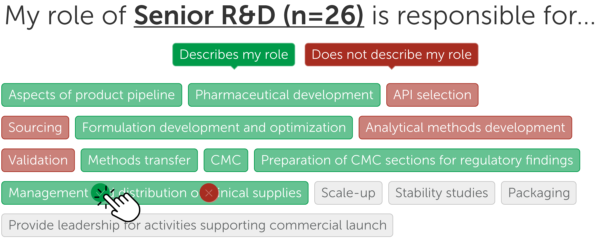Custom Research Case Study
Persona Development

The Client
ISR was contacted by the vice president of content marketing at a Top 5, global CDMO with the question ‘How do we better understand our customers’ roles and responsibilities as they relate to outsourced contract manufacturing services?’ The client had three goals with this question. First, the client had drafted preliminary personas they wanted to refine and pressure test. Second, the client was interested in identifying the marketing channels their customers and prospects preferred to use so the client could tailor messaging for those media. Finally, the client wanted to get a better sense of decision-makers’ role in the outsourcing decision-making process. With this information, the organization’s content marketing team could ensure their budget and efforts were targeted in the most efficient and cost-effective manner.
The Solution
Learn directly from real decision-makers and influencers to create and/or refine personas in a way that effectively represents the buying universe.
What is Persona Development?
Personas are an organization’s understanding of the kinds of customers that make up their core customer base. One persona represents a grouping of roles and responsibilities that encompass the type of people a company would typically sell to. For a CDMO like our client, this could include people like the executive management team at a pharmaceutical company.
Persona development is an important exercise for any marketing or business development team that is serious about efficiently targeting prospective customers. For this reason, it is crucial to ensuring that your organization has a strong grasp of the varieties of customers that they can pursue, and that the language used to reach out to those customers properly reflects their roles and responsibilities. In this case, eight (8) personas were included in the market research study.
The Project
ISR presented a traditional project in three stages. First, a qualitative phase where in-depth-interviews provided a “day in the life” perspective to begin capturing the actual language used by the target customers. The second phase used that language to develop a quantitative, web-based survey to determine how effective those terms are at representing target customers. Finally, another qualitative phase was conducted to gather direct feedback from target customers on how to fine-tune the language even further.
To ensure a sample that would be representative for a global CDMO, respondents were sourced from both North America and Europe, and from a wide range of company sizes. The participants were stratified to ensure there was a large enough sample for Large, Mid-size and Small companies, and by persona/geography. For instance, ensuring that there was a statistically significant sample of participants who fit into Persona Type A that also were from a small, North American organization.
The first phase of the project consisted of qualitative phone interviews with 15 respondents over four weeks. To understand respondents’ direct views on how they perceived their role, ISR asked them questions such as: how they would describe their responsibilities at a basic level, what their everyday challenges look like, what their successes look like, and how they interact with service providers. Instead of using this information to begin pressure testing the client’s initial personas, this phase was intended to gather language that other prospective customers would identify with.
During the four weeks that comprised the first phase, the second phase was already underway in the form of questionnaire design. The quantitative, web-based survey of 150 respondents was designed to fit participants into their predicted persona type, and at the end of the survey, participants were asked if they identified with the persona type they were coded as. If they disagreed, they were presented with the next best fit. Then, the respondent was presented with a segmented paragraph of roles and responsibilities associated with their persona and asked to click on the portions they agreed fit their position. Finally, the respondents were asked to fill in the holes of any language that was missed, worded improperly, or just typically described in a different manner from their viewpoint.
After the eight weeks of collecting responses through the web survey tool, analyzing the data, and producing a report, the third phase of the project commenced, consisting of 15 additional telephone interviews. During these three weeks, the refined personas were presented to the interviewees for pressure testing. The goal of this step was to ensure everything we learned in the first two stages resonated.
The Result
A methodology for identifying personas, and data to support content marketing efforts.

The result of the project was a tool that the client was able to use to consistently identify personas. After the project, the client was able to use this tool to go back through their database of contacts and assign them to persona types. With a good understanding of these separate personas, they were able to begin crafting messages that addressed those personas’ goals and pain points. At this point, the client and ISR were able to begin defining content ideas per each persona, a process the client would be able to use to generate more content ideas going forward after the project’s end. Furthermore, ISR used our internal resources and data to identify what topics the persona was interested in, what channels the persona preferred to ingest that content, and when, within a project lifecycle, they were looking for that content.
The client found the project data to be so valuable and actionable to their business that they decided to reengage ISR’s services on Persona Development for another business unit of the company.

